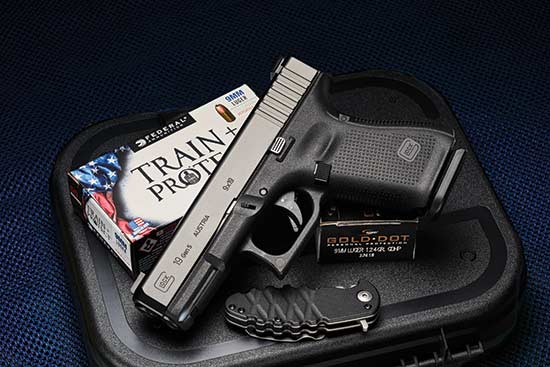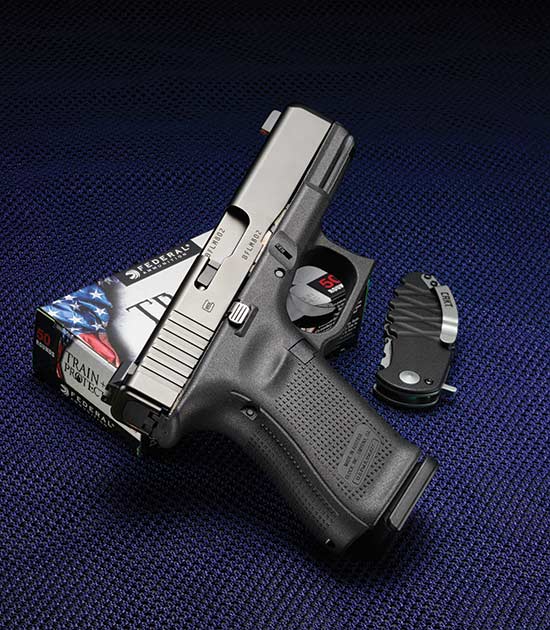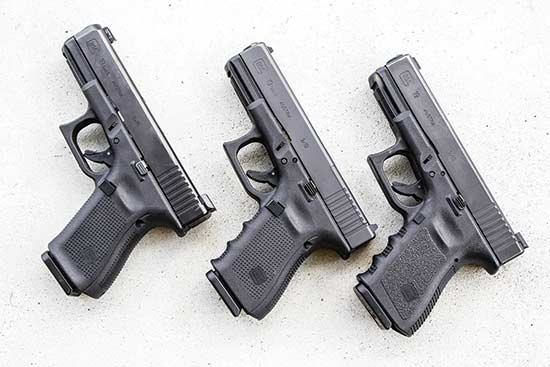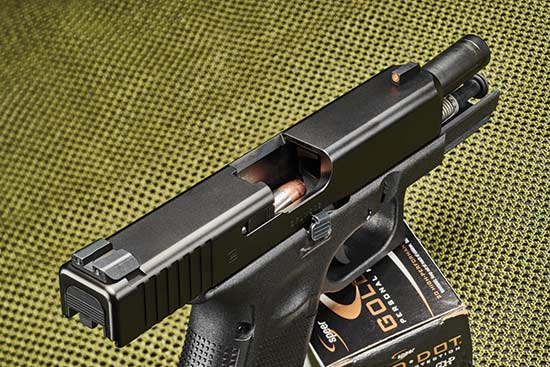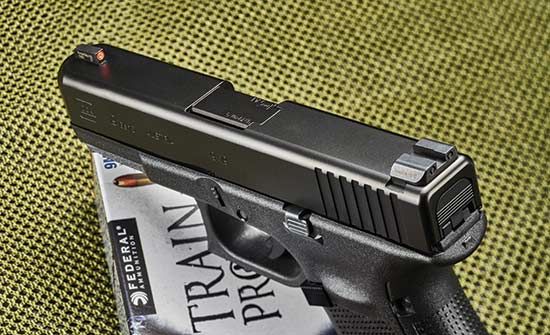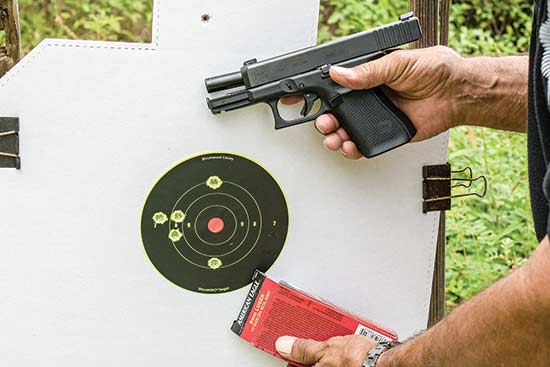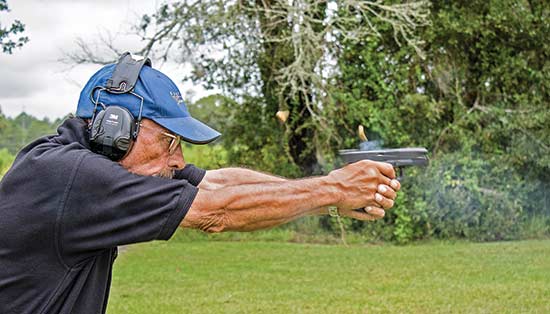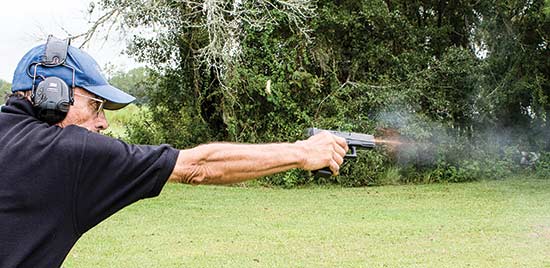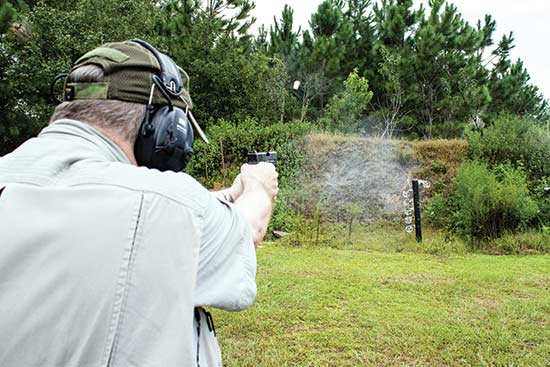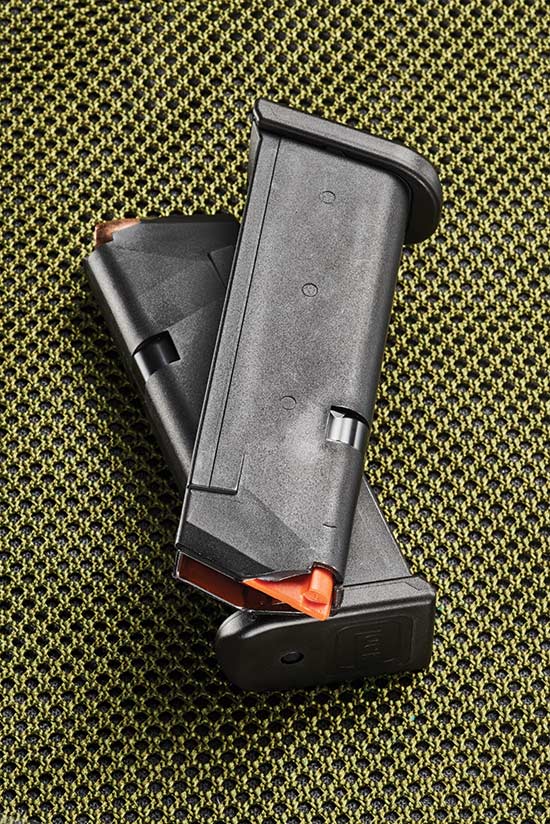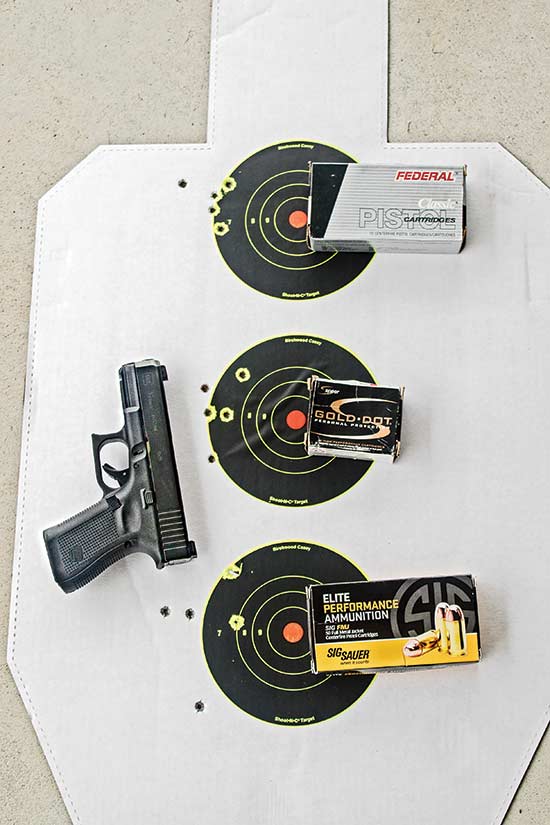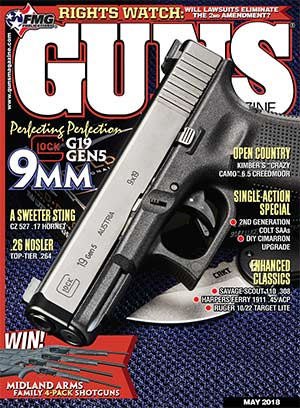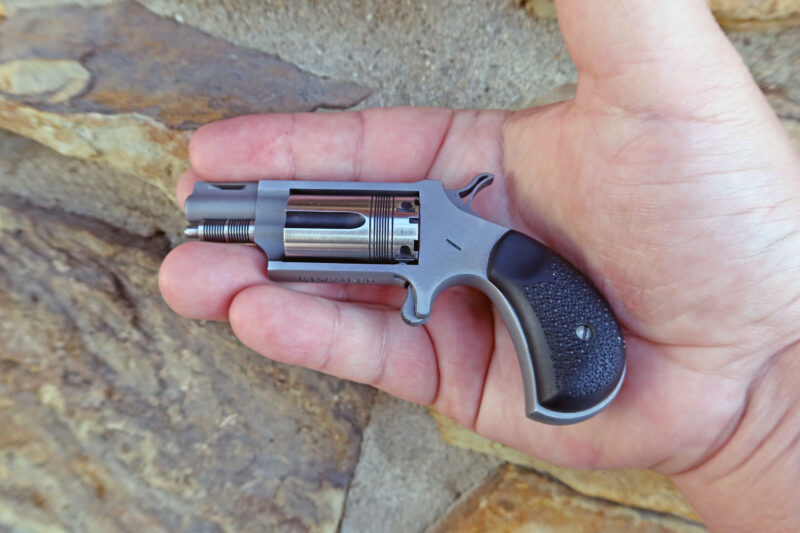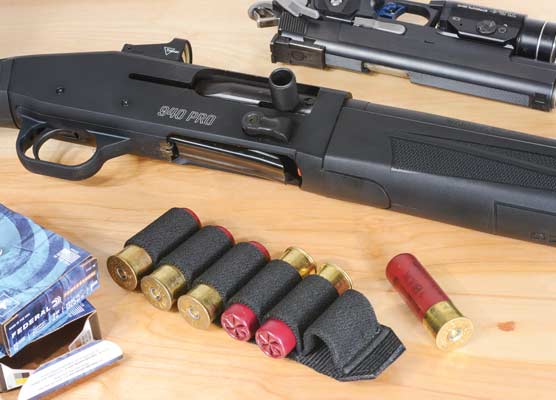A Generational Advance
“The Gen5 Glock 19 Arrives With Very Worthwhile Enhancement."
There has been much discussion about the new Gen5 GLOCK 9mm pistols. They don’t derive from the military’s MHS (Modular Handgun System) testing. Rather, they are almost perfect clones of the M-series, created originally for the Federal Bureau of Investigation to Bureau specs, and now in use by other agencies including the Indianapolis Metro Police Department.
The only real difference seems to be the sights, and the coating on the trigger group. I got to shoot the Bureau-issue 19M in early February of 2016 at the FBI Academy in Quantico, Va. I was impressed with the M-series then, and after extensive shooting of a test sample, am impressed with the Gen5 G19 now. Let’s look at the Gen5’s features.
The most visible change in the Gen5 guns is the straight front grip. Since Gen3, GLOCKs have come with fingergrooves. Folks tend to love ’em if they fit their fingers, and hate ’em if they don’t. FBI specified straight front as did lots of users. GLOCK logically decided to go straight front with Gen5. The Bureau also wanted a big relief cut in the front of the butt to facilitate emergency removal of stuck magazines, a feature we haven’t seen on GLOCKs since Gen2. GLOCK obliged, with a half-moon cut that’s some 0.80-inch across, about the same as on Gen2.
A second look will show the slide tapers toward the muzzle. Subjective aesthetics has little to do with it. This useful feature aids 1-handed holstering by feel, in the dark or during an emergency demanding “eyes front.”
Trigger Pull
The only externally visible Gen5 difference in this respect is the smooth-faced rather than grooved-face finger surface, which is “A Good Thing” right there. Press the trigger, however, and someone familiar with GLOCKs will realize this is much different than the systems to which we’ve grown accustomed. It has a lot in common with the trigger systems of the slim-line G42 .380 and G43 9mm subcompacts of recent years.
Your traditional GLOCK with a 5.5-pound trigger has a long, light take-up before it meets the firm resistance we colloquially call “the wall,” and then only about 1/10 inch of resistance before the shot breaks. It’s rather like an old Mauser or Springfield military rifle trigger. The Gen5 gives a firm resistance from the beginning of the trigger pull, and changes much less when it hits the wall, which it sort of rolls through. The closest I can compare it to is the NY-1 aka “New York Trigger” combined with a 3.5 pound connector, which has been approved by the firm for duty for many years and which a lot of Austrian pistol fans think is the ideal street trigger system. The Advanced GLOCK Armorer on my test team concurs.
The test pistol came in a box marked “5.5 LB” for trigger weight. On our Lyman digital gauge, Gen5 G19 serial number BFLM802 averaged 6.075 pounds when applied to the toe of the trigger (a traditional weighing spot), and 6.76 pounds weighed at the center of the trigger, where the index finger normally rests in actual firing. This is a lot less difference between these points than we usually find on a pivoting-trigger pistol. The FBI-specific “M pistols,” by contrast, are spec’d for a 4.5- to 5.5-pound pull-weight range.
The firm resistance at the beginning of the pull is a safety feature, given that under stress vasoconstriction interferes with our ability to feel light, subtle resistance. It’s why I’ve been a fan of the NY-1 option since its introduction to the New York State Police about 30 years ago. The smooth roll of the trigger is—from a marksman’s point of view—what’s endearing about this new trigger system. This writer concludes the Gen5 has the best factory trigger operation yet offered as standard.
An FBI agent I know, a shooter on his own time who now has several thousand rounds through his issue 19M, gave me the most dramatic explanation I’ve heard yet of the difference between the new trigger and those of the earlier four generations. “The trigger pull on this one is like going up a ramp,” he said, “where the old one is like tripping over a curb.”
Accuracy
As usual, I tested the gun with ammo representing the three most popular bullet weights for the caliber. For a 115 grain, I went with the famously accurate Federal 9BP, a conventional cup-and-core jacketed hollowpoint with long, subtle jacket skives to aid expansion. This was the load handgun ace Tom Campbell used back in the day for accuracy-intensive matches like the Bianchi Cup in his 9mm Smith & Wesson. It lived up to expectation with the Gen5 G19, with all five shots in 2.15 inches. The best three of those formed a 1.05-inch cluster.
For a 124 grain, I went with Speer’s +P Gold Dot, which from NYPD to Las Vegas Metro has proven to be one of the most dynamic man-stoppers ever produced in 9mm Luger. The overall 5-shot group measured 3 inches on the nose. Four of those shots were in 1.70-inch center to center, and the best three, in 1.15.
The 147-grain subsonic load was the relatively new SIG training round, the only roundnose full metal jacket 147-grain 9mm I know of over the counter. Overall group went 4.35 inches, due largely to one errant shot. The other four were in 2.55 and the best three in exactly 2.00 inches.
This particular test gun came out of the box shooting high and left. It turned out that a 6 o’clock sight picture, with the front post level in the rear notch and balancing a 6-inch Birchwood Casey Shoot-N-C bull’s-eye on top, delivered the shots where intended for elevation. However, all three bullet weights shot 2-1/2 to 3 inches left.
No problem. Just a job for a sight-pushing tool. The optional AmeriGlo rear sight was easy to move in its dovetail, without ever feeling loose. As sighting-in progressed, I tested with a couple of different economy-priced 115-grain full metal jacket “ball” rounds. The American Eagle load from Federal, which I use a lot in matches and personal training, put all five shots in 3.30 inches and the best three was the best such cluster of the test: 9/10 inch. I then tried another cheap 9mm practice round, the 115-grain Remington-UMC. I didn’t have another bull’s-eye to stick on the IPSC silhouette I was using for a backer, so I just “went for the throat” and balanced the square head of the target atop the post-in-notch sight picture. The group was still a bit left, but center for elevation. It measured 2.25 inches for all five hits, and 0.95 for the best three.
Either I was getting better, or the gun was breaking in… But, seriously, it explains why I do those two group measurements. The “best three,” I’ve learned over decades, will about equal what all five would have done from a Ransom Rest assuming no “called flyers” and an experienced shooter on the gun. With five different loads the Gen5 GLOCK 19 had done very consistent “best threes” of 1.05, 1.15, 2.00, 0.90, and 0.95 inches. That’s an average of 1.21 inches—less than 1-1/4 inches at 25 yards hand held from a Matrix rest on a concrete table.
Is the company justified in calling that a “Marksman” barrel? In a moderately-priced polymer compact 9mm, I would have to say, “Yes.”
Is it an improvement over previous models? Well, I looked up a test done on the same range with the same protocols a decade or so ago with a G34. This is the pistol Robert Vogel has used to become the indomitable World Champion of the International Defensive Pistol Association and is famous for its accuracy. In the test, the G34 with 5.3-inch barrel averaged 1.10 inches for “best three” measurements—only about a 1/10-inch tighter than the 4-inch barrel Gen5 G19 carry gun. Yes, I’d say Gen5 is an improvement so far.
The Gen5 barrel is crowned and has what appears to be conventional land-and-groove rifling, described by the manufacturer as “GLOCK-improved polygonal rifling.” Does this mean the firm will approve it for use with all-lead bullets? I asked, and the answer was “No.”
Subjective “Shootability”
The flared butt of the Gen5 is supposed to speed reloads. I can’t say I felt a lot of difference there. The tapered top of the standard double-stack magazine has always made it seem easy-loading to me. Some shooters, with hands larger than mine, liked the flare because it kept the pinkie finger of the gun hand from being pinched between frame and magazine floorplate during speed reloads. The new Gen5 magazines with orange-red followers ran fine, and the follower was easier to see for cartridge counting through the observation windows at the back of the magazine. The 15-shot mags were easy for even old, arthritic fingers to load by hand. Gen5 mags fit older GLOCKs of the same model and caliber, and vice-versa.
In carrying the 31-ounce (loaded) G19 daily for most of a month with an assortment of holsters, I found the flare at the bottom would dig into the lowest of my floating ribs in a particularly high-ride scabbard. In a Precision Holsters IWB, which I wound up wearing most of that time, it was low enough this problem disappeared. The flare on the outer edge might be a problem concealing under a very tight garment, but it was a non-issue in my testing, including a week in Texas wearing a tailored suit for a couple of days of CLE teaching.
All of my own G19 holsters fit the Gen5 fine. One large agency, however, has had to order new Safariland plainclothes security holsters because the ones for their older GLOCKs came up high on the outer edge and were a bit too tight for the ambidextrous slide stop levers. Which, by the way, seem to protrude on the left hand side a tiny bit more than older standard levers.
I taught most of a MAG-40 class in the Midwest with the Gen5 G19, the 40-hour program culminating with a police-style qualification which began with what we call a Pace-Setter: The staff shot the course to show the students the best way to perform on each stage. When about 30 people who paid you to teach them are watching with the unspoken question—“Hey, can my instructor do what he’s telling us to do?”—it definitely provides your daily adrenaline requirement. The easy manipulation of the Gen5 G19 allowed me to sail through the 60 shots with a perfect score. If it does that for an arthritic old fart like me, well, it’ll probably work for you, too.
The Gen5 brings back the Gen2’s deep half-moon cut at the front of the butt, to help a hand claw out a magazine that might be stuck in place due to a defective round. Some folks complained on the internet it was sharp and uncomfortable against their pinkie finger. I did not find it so, and neither did any of our several testers with widely varying hand sizes. It’s easy enough to correct if it does become bothersome.
The only downside: If the triggerguard of a GLOCK gives you “GLOCK knuckle” on your middle finger, the Gen5 straight grip front configuration does not seem to cure that.
Reliability
This was the first of the ballyhooed Gen5s most folks had seen at the time of the test, and everybody wanted to shoot it. I deliberately left it with only the lube it had come with, to see how this affected reliability. We were soon well over 1,000 rounds of just about everybody’s ammo (no handloads, though). No malfunctions were noted. Even deliberate limp-wristing did not induce malfs. And no one reported BTF, the dreaded “brass-to-face” ejection pattern.
Our test team, from the 5-foot tall lady to the large males, gave the Gen5 a big thumbs up. Final assessments are rarely so unanimous. At least two of our testers immediately went out and ordered their own Gen5s. That says something.
I can’t confirm it with attribution, but word is that during FBI’s testing, some M-series GLOCKs went 20,000 rounds apiece without a single malfunction. Really, it’s hard to ask for more than that.
Yes, we were aware IMPD had experienced some breakages with their first production run 17Ms. We were also aware this had long since been traced to a batch of faulty springs, and had been corrected straightaway.
Bottom Line
I’ve been shooting GLOCKs since they hit American shores, and carrying and competing with them regularly for more than a quarter century. While I have mixed feelings about the flared mag well, in every other respect this Gen5 G19 has become my new favorite GLOCK 9mm. I think it has the best self-defense trigger the firm has ever offered as standard. And, yes, I’m sending them my personal check, and the test gun is staying with me!
GLOCK
(770) 432-1202
https://gunsmagazine.com/company/glock-inc/
